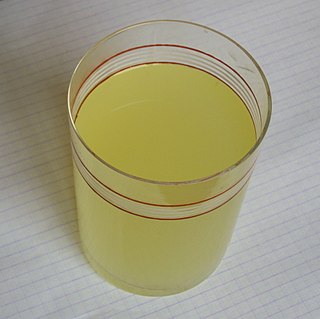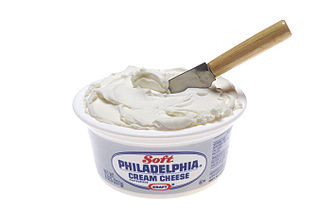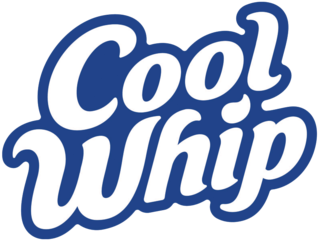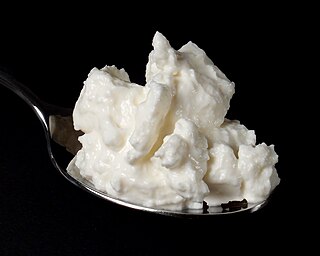Related Research Articles

Whey is the liquid remaining after milk has been curdled and strained. It is a byproduct of the manufacturing of cheese or casein and has several commercial uses. Sweet whey is a byproduct resulting from the manufacture of rennet types of hard cheese, like cheddar or Swiss cheese. Acid whey is a byproduct brought out during the making of acid types of dairy products, such as strained yogurt.

Cottage cheese is a curdled milk product with a mild flavour and a creamy, heterogeneous, soupy texture, made from skimmed milk. An essential step in the manufacturing process distinguishing cottage cheese from other fresh cheeses is the addition of a "dressing" to the curd grains, usually cream, which is mainly responsible for the taste of the product. Cottage cheese is not aged.

Curd is obtained by coagulating milk in a sequential process called curdling. It can be a final dairy product or the first stage in cheesemaking. The coagulation can be caused by adding rennet, a culture, or any edible acidic substance such as lemon juice or vinegar, and then allowing it to coagulate. The increased acidity causes the milk proteins (casein) to tangle into solid masses, or curds. Milk that has been left to sour will also naturally produce curds, and sour milk cheeses are produced this way.

Buttermilk is a fermented dairy drink. Traditionally, it was the liquid left behind after churning butter out of cultured cream. As most modern butter in Western countries is not made with cultured cream but uncultured sweet cream, most modern buttermilk in Western countries is cultured separately. It is common in warm climates where unrefrigerated milk sours quickly.

Processed cheese is a product made from cheese mixed with an emulsifying agent. Additional ingredients, such as vegetable oils, unfermented dairy ingredients, salt, food coloring, or sugar may be included. As a result, many flavors, colors, and textures of processed cheese exist. Processed cheese typically contains around 50 to 60% cheese and 40 to 50% other ingredients.

Cream cheese is a soft, usually mild-tasting fresh cheese made from milk and cream. Cream cheese is not naturally matured and is meant to be consumed fresh, so it differs from other soft cheeses such as Brie and Neufchâtel. It is more comparable in taste, texture, and production methods to Boursin and mascarpone. Stabilizers such as carob bean gum and carrageenan are often added in industrial production.

Cheez Whiz is a brand of processed cheese sauce or spread produced by Kraft Foods. It was developed by a team led by food scientist Edwin Traisman (1915–2007). It was first sold in 1952, and, with some changes in formulation, continues to be in production today.

Ricotta is an Italian whey cheese made from sheep, cow, goat, or Italian water buffalo milk whey left over from the production of other cheeses. Like other whey cheeses, it is made by coagulating the proteins that remain after the casein has been used to make cheese, notably albumin and globulin.

Cool Whip is an American brand of whipped topping manufactured by Kraft Heinz. It is used in North America as a topping for desserts, and in some no-bake pie recipes as a convenience food or ingredient that does not require physical whipping and can maintain its texture without melting over time.

Maytag blue cheese is produced on the Maytag Dairy Farms just outside of Newton, Iowa city limits.

American cheese is a type of processed cheese made from cheddar, Colby, or similar cheeses, in conjunction with sodium citrate, which permits the cheese to be pasteurized without its components separating. It is mild with a creamy and salty flavor, has a medium-firm consistency, and has a low melting point. It is typically yellow or white in color; yellow American cheese is seasoned and colored with annatto.

A milk substitute is any substance that resembles milk and can be used in the same ways as milk. Such substances may be variously known as non-dairy beverage, nut milk, grain milk, legume milk, mock milk and alternative milk.

A non-dairy creamer, commonly also called tea whitener or coffee whitener or else just creamer, is a liquid or granular product intended to substitute for milk or cream as an additive to coffee, tea, hot chocolate or other beverages. Most do not contain lactose and therefore are commonly described as being non-dairy products, although many contain casein, a milk-derived protein.

Strained yogurt, Greek yogurt, yogurt cheese, sack yogurt or kerned yogurt is yogurt that has been strained to remove most of its whey, resulting in a thicker consistency than normal unstrained yogurt, while still preserving the distinctive sour taste of yogurt. Like many types, strained yogurt is often made from milk enriched by boiling off some water content, or by adding extra butterfat and powdered milk. In Europe and North America, it is often made from low-fat or fat-free cow's milk. In Iceland, a similar product named skyr is made.
Milk protein concentrate (MPC) is any type of concentrated milk product that contains 40–90% milk protein. The United States officially defines MPC as "any complete milk protein concentrate that is 40 percent or more protein by weight." In addition to ultrafiltered milk products, the MPC classification includes concentrates made through other processes, such as blending nonfat dry milk with highly concentrated proteins, such as casein.

Ymer is a Danish soured milk product with 6 percent protein. Compared to standard yogurt, it has a thicker, creamier consistency and a higher protein content. It has a slightly buttery taste and may be very subtly fizzy due to slight carbonation from the lactic fermentation. It was launched commercially in the 1930s. It is made by fermenting whole milk with the bacterial culture Lactococcus lactis.

Velveeta Shells & Cheese is a shell pasta and cheese sauce food product that debuted in the United States in 1984, as part of the Velveeta brand products. Its ingredients, texture, and flavor are very similar to macaroni and cheese. The product is a shelf-stable food.

Quark or quarg is a type of fresh dairy product made from milk. The milk is soured, usually by adding lactic acid bacteria cultures, and strained once the desired curdling is achieved. It can be classified as fresh acid-set cheese. Traditional quark can be made without rennet, but in modern dairies small quantities of rennet are typically added. It is soft, white and unaged, and usually has no salt added.

Sour cream is a dairy product obtained by fermenting regular cream with certain kinds of lactic acid bacteria. The bacterial culture, which is introduced either deliberately or naturally, sours and thickens the cream. Its name comes from the production of lactic acid by bacterial fermentation, which is called souring. Crème fraîche is one type of sour cream with a high fat content and less sour taste.

Halo Top Creamery is an ice cream company and brand sold in the United States, Australia, Mexico, Canada, Ireland, New Zealand, the Netherlands, Germany, Denmark, Taiwan, Hong Kong, South Korea, Austria, United Kingdom and the United Arab Emirates. The brand is marketed as a lower-calorie alternative, partially substituting sugar with stevia, a plant-based sweetener, and erythritol, a sugar alcohol.
References
- ↑ "Proteins provide pleasure to lowfat products. (Formulation Challenge). Formulated from whey and soy". Prepared Foods . 172 (1): 74. January 2003. Archived from the original on 2016-03-26. Retrieved October 23, 2012.
- 1 2 3 4 5 6 Peter Coy (January 27, 1988). "Discovery Of Simplesse Was An Accident With PM-Fat Substitute Bjt". Associated Press . Retrieved October 22, 2012.
- 1 2 U.S. patent 4,734,287
- 1 2 3 4 "Natural Fat Substitute Likely In 18 Months". San Jose Mercury News . Associated Press. January 27, 1988. p. 4A. Retrieved October 22, 2012– via Associated Press.
- ↑ U.S. Trademark 73,707,968
- ↑ "F.D.A. Backs New Version Of Simplesse". The New York Times . August 14, 1991. Retrieved 2008-10-26.
- 1 2 3 Gholam Rahman (July 4, 1996). "Simplesse Can't Be Used In Cooking". Food. Palm Beach Post . p. 4.